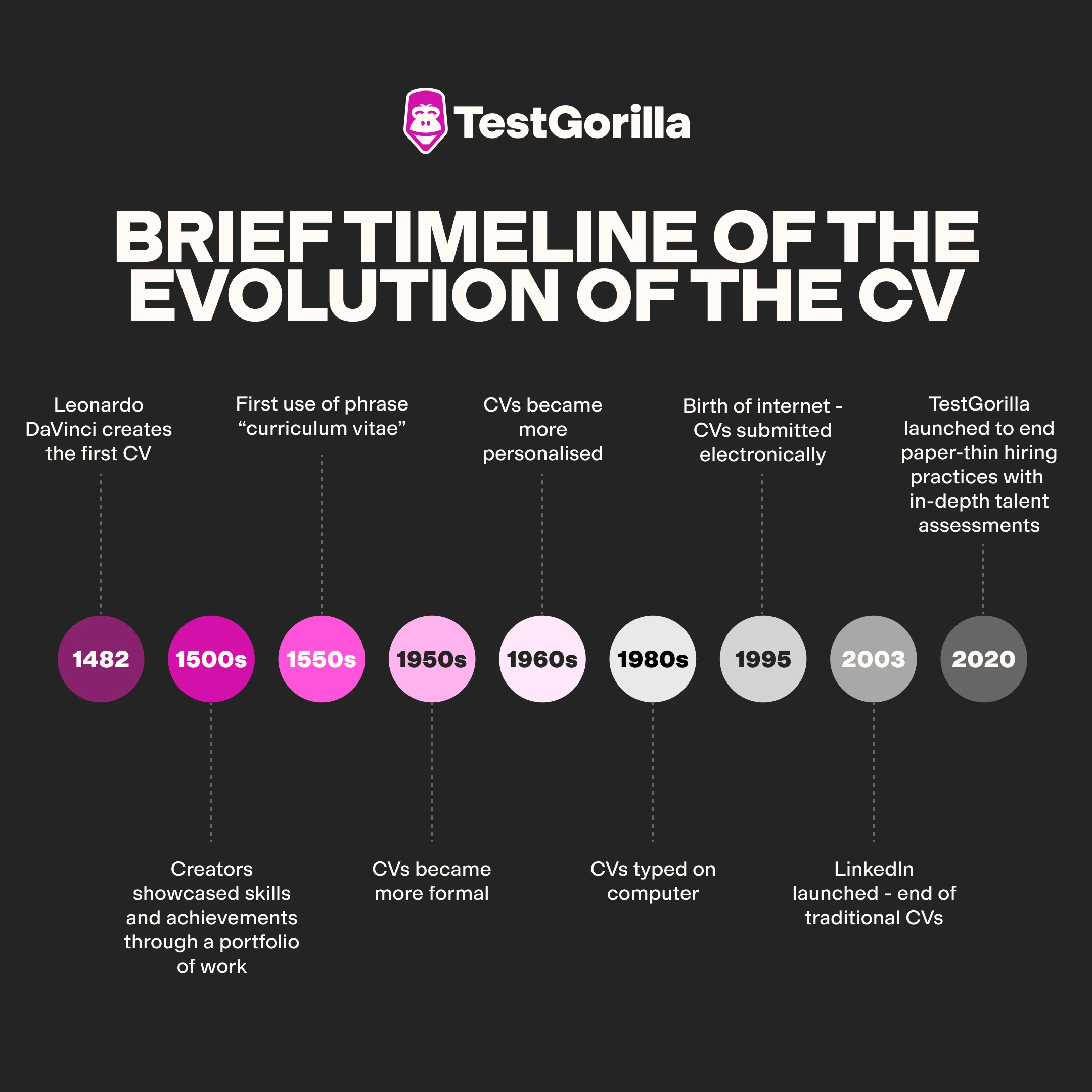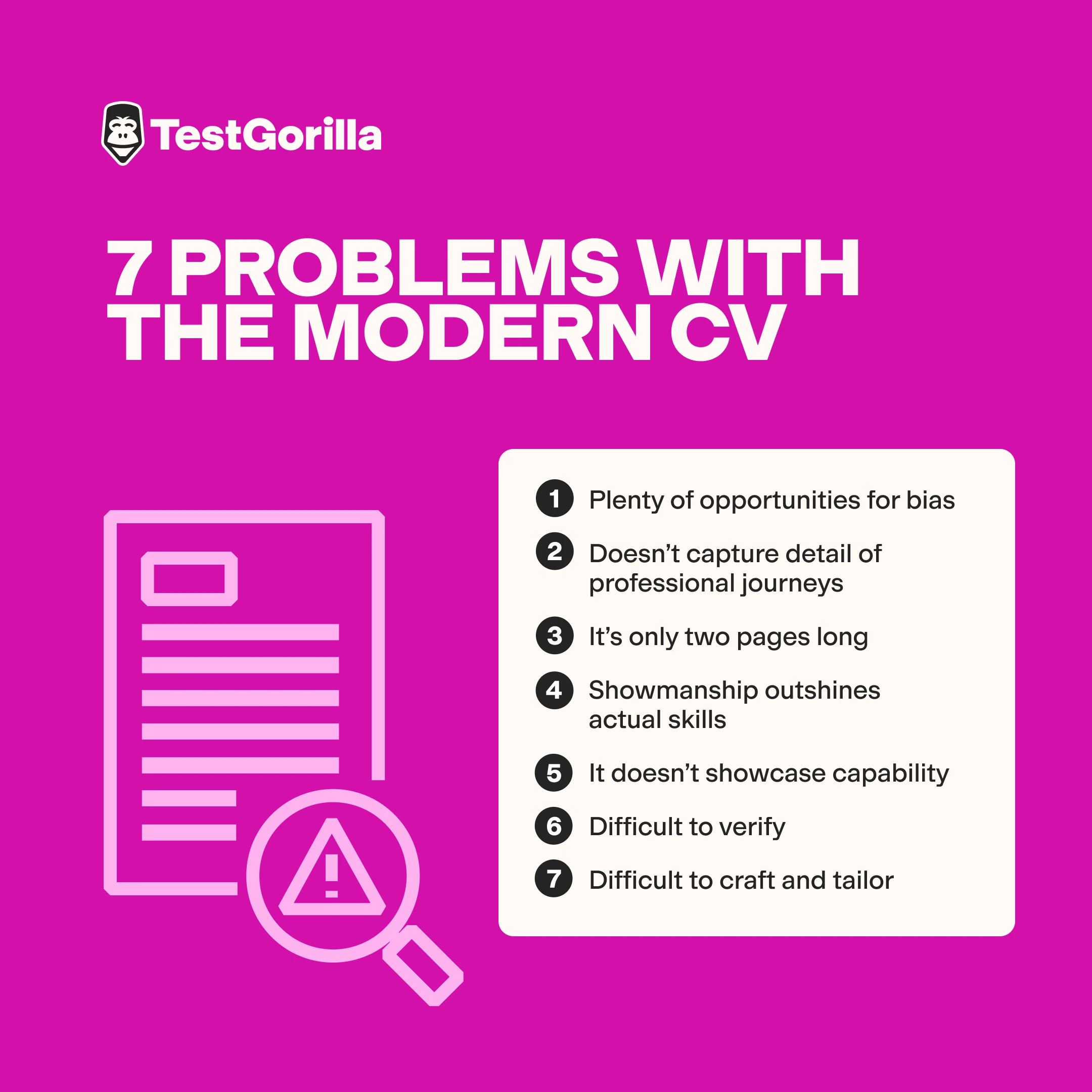The CV – or curriculum vitae – is a widespread part of the modern job application process. And for candidates, crafting the perfect CV that effectively showcases their skills, experience, and personality can feel like a never-ending task. How did this oh-so-”important” piece of paper (or digital document) come to be?
Read on to learn all about the history of the CV, including where it came from, how it developed into what we know today, why it shouldn’t be as important as some people think it is, and what you can focus on instead of the CV for your next hiring campaign.
Key takeaways
The first CV was created by Leonardo DaVinci in 1482, but the CV didn’t become a mainstream part of job applications until around 1960.
While CVs had their place once upon a time, they’ve become less useful and more problematic in modern hiring practices.
Modern, skills-based hiring practices like candidate assessments are much better for screening candidates.
A brief history of the CV
The CV has certainly come a long way over the centuries. Here’s a brief timeline of its evolution.
1482
Leonardo DaVinci is known for inventing the parachute, scuba gear, and the anemometer. But, did you know he’s also credited with creating the first CV?
While looking for work, he wrote a letter to the Duke of Milan, highlighting his skills and experience. In this letter, he offered to design bridges, build boats, sculpt – and more. Many consider this to be the very first CV.
1500s
Although CVs still weren’t commonplace, many sculptors, artists, inventors, and craftsmen from the Middle Ages kept evidence of their accomplishments through a portfolio of work. They’d then show this – one of the earliest versions of the CV – to potential employers.
While there was no traditional structure to these portfolios, they served the same purpose as today's CVs: showcasing skills and achievements to land new opportunities.
1550s
Did you know that the phrase “curriculum vitae” is Latin for “course of life” – and that this term was first used in the 16th century? Back then, it probably referred to scholarly or academic pursuits – but it planted the seeds for the modern, structured CV we use today.
💡 Guess what? Although “CV” is generally considered to be a British term, it’s often used in US academia to represent a multi-page document highlighting someone’s academic achievements, research areas, and professional experience.
1950s
Fast forward to 1950, where CVs became more formal.
But, these one-page documents weren’t CVs as we know them. While they included important information like candidates’ names and contact details, 1950s employers also requested candidates’ ages, weights, and parents’ backgrounds. Plus, they asked for a “professional” picture of each candidate wearing formal workwear.
1960s
The 1960s is when we began to see more personalized CVs. Details like hobbies, interests, and other personal information helped applicants stand out from the crowd and gave employers a sense of who they were.
1980s
As word processors and early computers became more widespread, so too did the formal, typed CVs. Candidates were able to format CVs properly, giving rise to the familiar layout we know today.
1995
With the birth of the internet came online directories, job hunting websites, and the ability to submit CVs electronically. This made the job application process much faster – and opened up a world of new opportunities for job seekers.
2003
LinkedIn was launched in 2003. Hailed as the end of traditional CVs, it became the go-to platform for professionals to showcase their work experience, skills, and education – and to network with employers and recruiters.
2020
Our talent discovery platform – TestGorilla – launched in 2020, promising to end paper-thin hiring practices and bring more depth to the recruitment process. This has prevented many employers from over-relying on CVs when screening candidates. It’s even enabled some to ditch CV screening altogether!
Just how, do you ask? TestGorilla enables candidates to showcase their abilities through skills-based assessments – so businesses don’t need to rely on traditional CVs to screen them. This approach helps reduce bias and makes sure hiring decisions are based on candidates’ actual capabilities – not just what they’ve written (or typed) on a piece of paper.
The best insights on HR and recruitment, delivered to your inbox.
Biweekly updates. No spam. Unsubscribe any time.
7 problems with the modern CV
While the formats of CVs have evolved with technology, there’s still much about the modern CV that hasn't kept up with the rest of the world. Here are seven common problems with CVs as we know them today.
1. There are tons of opportunity for bias
A CV without context is simply a piece of paper containing info that’s open to interpretation – and sometimes even bias. Details like candidates’ names, ages, or even their educational backgrounds can lead recruiters to unfairly dismiss them before they even step into an interview.
For instance, a recruiter might dismiss a candidate because they’re “too old” or haven't worked for a big-name company. Or, they might privilege candidates with fancy degrees – but who lack the skills they need. This prevents talented candidates from getting a fair chance.
2. It’s a snapshot, not the landscape
Through CVs, candidates make their experience sound incredible, team efforts sound like solo gigs, and minor tasks sound like major achievements. However, this carefully curated snapshot of their careers leaves out details like the challenges they overcame, the real scope of their contributions, or how well they work in a team.
A CV doesn’t always capture the nuances of their professional journeys – making it harder for you to see their authentic capabilities.
3. It’s only 2 pages long
Someone might be able to fit their accomplishments, qualifications, and job history on 1-2 pages when they’re in their early or mid-career. But, as they gain more experience, cramming all their achievements, skills, and roles into just two pages becomes a real challenge.
This restriction can force them to leave out important details that showcase their growth and abilities. So, you don’t see the full scope of their expertise.
4. Showmanship outshines skills
We’ve all been in the position of reviewing an all-singing, all-dancing CV that looks brilliant. But, scratch below the surface and there’s very little substance to back it up. Unfortunately, flashy design and fancy formatting can sometimes distract from what really matters – a candidate’s actual skills.
5. It doesn’t showcase capability
A CV doesn’t always reflect what a candidate can do, only what they’ve done, which can be limiting for those ready to grow into new roles or take on fresh challenges. For example, you may miss out on great candidates simply because their CV doesn’t scream experience – even though their skills and drive could make them a perfect fit.
This can lead you to hire for experience rather than potential – which could mean missing out on some great hires.
6. Difficult to verify
In our 2023 annual report, we surveyed employers and found that 51% of them struggle to determine when resumes are accurate. In addition, 43% have trouble determining the skills their applicants actually possess using their resumes, while another 43% struggle to rank their applicants using resumes.
The gist? It’s difficult to verify what’s in a CV without incorporating other recruitment efforts – and employers often won’t use other efforts during the initial screening phase if they’re already relying on resumes.
With no fact-checking upfront, what’s to stop candidates beefing up their experience to set them apart from the crowd, or using inaccurate AI-generated resumes? Exaggerated claims can slip through the cracks, while honest candidates with less impressive resumes might be dismissed. The result? Mis-hires.
7. Difficult to craft and tailor
Finally, modern CVs take so much time for candidates to craft – especially since they’re encouraged to tailor their CVs to each role they apply for and apply fancy, eye-catching formatting. On top of this, they must make sure their CVs are “algorithm friendly” for employers using CV screening software.
Is putting candidates through the time-consuming process of creating and tailoring these documents worth it?
What does the future hold for recruitment, and how does the CV fit in?
While some employers firmly believe there’s still a place for CVs in modern hiring, our take is that CVs are too often grossly misused and filled with fluff. To get the most out of your recruitment campaigns, try using a stronger screening method.
How? With TestGorilla: our talent discovery platform offering you the tools to make smarter, data-driven hiring decisions. TestGorilla enables you to assess candidates' skills directly – giving you a true insight into what they can do and eliminating the need to screen CVs at the top of the hiring funnel.
By using scientifically designed assessments, you can evaluate everything from technical expertise to problem-solving abilities to communication skills – all while reducing bias and making sure the process is fair for every applicant.
What’s more, you can create your own custom talent assessments by combining multiple skills tests. This way, you can nail down the exact skill set required.
Need a push? Consider this:
In our 2024 annual report, we learned that 98% of employers think skills-based hiring is more effective than relying on resumes (FYI: “resumes” are the US equivalent of CVs). While 78% of employers who used skills-based assessments after screening resumes were satisfied with their hires, 87% of those who used them before screening resumes were satisfied with their hires.
Enter a new era in recruitment with TestGorilla
First created in 1482, the CV is now pretty outdated. In a world where skills and potential are more important than what's written on a piece of paper, it’s time to move beyond the CV to more modern, skills-based hiring practices.
TestGorilla can help you find the right person for the job – not just the person with the best CV. With over 400+ tests in our test library, we give you the tools to evaluate candidates on the skills that matter most.
Sign up for your free trial or demo today.
FAQs
Is the CV a British thing?
The term “CV” is more commonly used in the UK than in the US – where the term “resume” is preferred. However, people in the US do use the term “CV” – but they’re often referring to an extra-long resume that’s used primarily in academic or other research-based settings.
How long should a CV be?
A CV is usually 1-2 pages long and consists of your key skills, experience, and qualifications. It can be longer if you have tons of career history – but it shouldn’t be longer than three pages.
You've scrolled this far
Why not try TestGorilla for free, and see what happens when you put skills first.
















